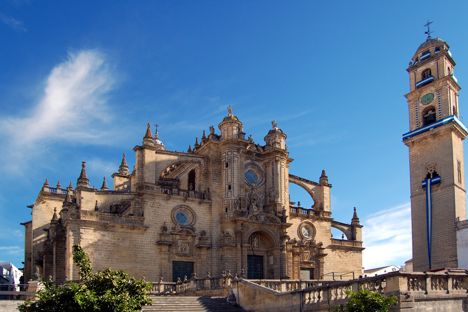
Jerez de la Frontera: the spiritual home of sherry
The home of sherry for over 3,000 years, Jerez is an area synonymous with the fortified wine. We delve into this celebrated wine-making region, taking a closer look at its sherry production and the influence the drink has on its food.
Jerez de la Frontera: the spiritual home of sherry
The home of sherry for over 3,000 years, Jerez is an area synonymous with the fortified wine. We delve into this celebrated wine-making region, taking a closer look at its sherry production and the influence the drink has on its food.
Famed for everything from its Moorish architecture to the art of flamenco dance, southern Spain has plenty to be proud of. However, one Andalusian city in particular (and the area surrounding it) is renowned for another reason. Jerez de la Frontera, more commonly known as Jerez, is the world capital of sherry. Also the name of the wider sherry-producing region, which encompasses the triangle of land between the cities of Sanlúcar de Barrameda, El Puerto de Santa María and Jerez de la Frontera, Jerez is synonymous with the much-loved tipple. But how is it that this small region became the home of sherry?
Although Brits only really fell in love with sherry in the sixteenth century when Francis Drake brought 3,000 kegs of it back from Cadiz, the area’s oenological traditions actually date back much further to around 1100 BC, when wine was first introduced to Spain. Vines were brought over by the Phoenicians, planted around the area that is now Jerez and soon began to flourish. Over the next 2,000 years, the region became increasingly well-known for its winemaking whilst sherry itself slowly became closer to what it is today, influenced by the Moors who introduced distillation to Spain (which would ultimately allow for fortification).
Throughout history the terroir of Jerez has always made the region appealing to winemakers. The warm, dry climate varies from vineyard to vineyard, meaning that some are best for growing the Palomino grapes used to make fino sherry, while others suit muscatel (vineyards close to the sea in particular) or pedro ximénez. However, it’s the area’s unique chalky albariza soil, accounting for around ninety percent of the vineyards in Jerez, which allows the vines to survive despite the lack of rainfall during the summer and irrigation not being allowed in the area. Its hyper-absorbent properties mean that it can retain water and drip-feed it to the roots throughout the hottest months to maintain optimal growing conditions.
These factors all ultimately contribute to achieving that recognisable sherry taste. For years winemakers around the world tried to replicate sherry but nothing ever came close to the original, which is why within Europe all sherry must now legally come from Spain. Jerez-Xérès-Sherry was also the first D.O, or Denominación de Origen to be recognised in Spain when the legal framework was established in 1933, meaning that all sherry produced in Spain and therefore Europe comes from this one wine growing region.
Over the years, sherry production hasn’t just become part of Jerez’s identity; it’s influenced the area’s culture as a whole. Nothing illustrates this better than the region’s food scene, which has evolved in harmony with the fortified wine. It’s actually said that Spain’s beloved tapas were first invented in Jerez as an accompaniment to sherry. In fact, the word ‘tapas’ comes from ‘tapar’, meaning ‘to cover’ in Spanish, as early forms of tapas tended to consist of thin slices of meat-topped bread, which would be placed on top of glasses of sherry between sips, to prevent fruit flies and sand from getting in. Across the whole of Andalusia there are hundreds of bars and restaurants where locals can go to enjoy a glass or two of sherry accompanied by some tapas, but Jerez actually has its very own type of sherry bar (which you won’t find anywhere else in Spain) called a tabanco.
Believed to have emerged in the seventeenth century, tabancos were originally places where Jerezanos would go to buy their sherry in bulk to enjoy at home, but they also doubled up as taverns where you could meet with friends whilst enjoying a few glasses. Today the ethos of tabancos is very much the same as back then – you can still buy your sherry from them or pop in for a drink – however, most of them also now serve tapas and various local dishes to pair with various types of sherry from the nearby bodegas. Tabancos are still somewhat of a secret to people who live outside of Andalusia, but in Jerez they’re an important part of the food and drink scene and would never have been invented were it not for the production of sherry.
Although Jerez’s beloved sherry is of course predominantly made for drinking, it has also come to be used in the kitchen as well with a number of traditional dishes from the local area using sherry to add flavour. One such dish is Riñones al Jerez, which you’ll regularly see on the menu at tabancos. Featuring kidneys cooked in onion, garlic and sweet pepper, the dish is completed with a dash of sherry to add some acidity and pairs beautifully with a crisp glass of fino. Meanwhile, Jerez’s take on the classic rabo de toro – a type of oxtail stew – is made by slowly cooking the meat in sherry (sometimes fino, sometimes the sweeter oloroso) rather than the traditional red wine. You’ll therefore struggle to find any restaurants or home kitchens in Jerez without a bottle of sherry to hand, whether for drinking or cooking.
There’s no doubt that it’s the home of sherry, but the fact of the matter is that Jerez’s ties to the drink go far further than simply production. Not only is the sherry industry key to the area’s economy, it’s an important part of the local culture and will continue to be for centuries to come.


